SIGN Guideline 108 (2008)
10 Preventing recurrent stroke in patients with primary intracerebral haemorrhage
- There is little evidence on prevention of recurrent vascular events following primary intracerebral haemorrhage.
10.1 BLOOD PRESSURE REDUCTION
- An RCT of secondary prevention in patients who had haemorrhagic stroke concluded that lowering blood pressure (non-acutely) following ICH using a combination therapy of ACE inhibitor and thiazide diuretic helps to prevent further vascular events. 228, 239 One group of patients received 4 mg perindopril and a second group received combination therapy of 4 mg perindopril and 2.5 mg indapamide. 228 Only 10% of the study population had haemorrhagic stroke, and these patients were younger with a mean age of 61 years compared to 64 for patients with ischaemic stroke. The risk reduction was greater for patients with (primary) haemorrhage. For ICH the RRR was 76% (95% CI 55 to 87) for combination therapy and 1% (95% CI -75 to 42) for perindopril alone compared to placebo.
- Lowering blood pressure (non-acutely) following ICH using a combination therapy of ACE inhibitor and thiazide diuretic should be considered to prevent further vascular events.
10.2 ANTIPLATELET AGENTS
- A systematic review on the safety of antithrombotic agents for patients with ICH concluded that aspirin should not be used acutely when the risk of future vascular events is low. The use of aspirin in the acute phase of ICH may be justified if there is a high risk of a cardiac ischaemic event. 240
- The use of aspirin following ICH is not recommended to prevent further vascular events when the risk of recurrence is low.
- The use of aspirin following ICH may be considered when there is a high risk of cardiac ischaemic events.
10.3 ANTICOAGULANTS
- No clinical trials were identified describing the use of anticoagulants after ICH. A decision analysis based on assumptions of risk of recurrent ICH and the risks associated with aspirin and warfarin therapy concluded that anticoagulation cannot be safely recommended for atrial fibrillation following either a lobar or deep ICH unless an individual is at very high risk of ischaemic stroke. 241 Aspirin may be a reasonable strategy for treating those with a prior deep ICH and an intermediate or higher risk of ischaemic stroke. 241
- Anticoagulation therapy following ICH is not recommended.
- In patients with a very high risk of further thrombotic or cardiac ischaemic events specialist advice should be sought.
10.4 STATINS
- An RCT of statin therapy to prevent recurrent stroke included 4,731 patients, 93 of whom had haemorrhagic stroke. Forty five patients were recruited to the treatment arm and received 80 mg of atorvastatin and forty eight received placebo. 214 Individual outcomes for these patients were not reported and the numbers were too small to be meaningful. In the treatment group there were 218 ischaemic strokes and 55 haemorrhagic strokes compared to 278 ischaemic and 33 haemorrhagic strokes in the placebo group. There were more haemorrhagic strokes in the atorvastatin group giving a hazard ratio of 1.66 (95% CI 1.08 to 2.55). The absolute risk increase was 0.9% giving an NNH of 107 over five years.
- There are risks and benefits of statin treatment in this population and the potential risk of intracerebral haemorrhage should be considered (see section 9.2).
- Statin therapy after haemorrhagic stroke is not routinely recommended unless the risk of further vascular events outweighs the risk of further haemorrhage.
- In this group of patients, their overall vascular risk profile should be taken into account when considering the risks and benefits of statin.
References:
214. Amarenco P, Bogousslavsky J, Callahan A, 3rd, Goldstein LB, Hennerici M, Rudolph AE, et al. High-dose atorvastatin after stroke or transient ischemic attack. New England Journal of Medicine 2006;355(6):549-59.
228. Progress Collaborative Group. Randomised trial of a perindoprilbased blood-pressure-lowering regimen among 6,105 individuals with previous stroke or transient ischaemic attack.[erratum appears in Lancet 2001 Nov 3;358(9292):1556][summary for patients in Can Fam Physician. 2002 Oct;48:1625-9; PMID: 12474869]. Lancet 2001;358(9287):1033-41.
239. Chapman N, Huxley R, Anderson C, Bousser MG, Chalmers J, Colman S, et al. Effects of a perindopril-based blood pressure lowering regimen on the risk of recurrent stroke according to stroke subtype and medical history: the PROGRESS Trial. Stroke 2004;35(1):116-21.
240. Keir SL, Wardlaw JM, Sandercock PA, Chen Z. Antithrombotic therapy in patients with any form of intracranial haemorrhage: a systematic review of the available controlled studies. Cerebrovascular Diseases 2002;14(3-4):197-206.
241. Eckman MH, Rosand J, Knudsen KA, Singer DE, Greenberg SM. Can patients be anticoagulated after intracerebral hemorrhage? A decision analysis. Stroke 2003;34(7):1710-6.



